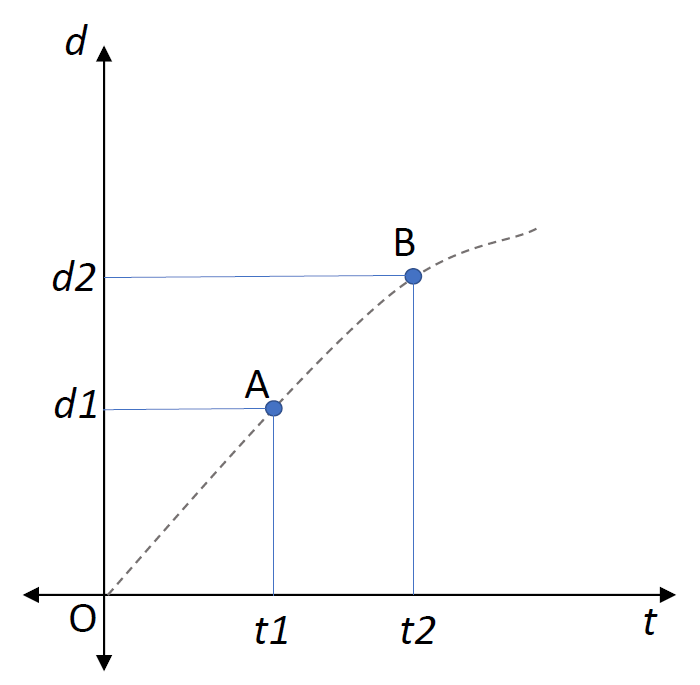
The slope of a distance-time graph of a moving body gives its
A. Speed
B. Displacement
C. Velocity
D. Acceleration
Answer
585k+ views
Hint: Slope of a graph between two variables $p$ on y-axis and $q$ on x-axis is $\dfrac{{\Delta p}}{{\Delta q}}$. Here $p$ is distance and $q$ is time. Speed is the distance covered by a body divided by the time taken.
Complete answer:
Two physical quantities are plotted on a graph with $d$ as the distance covered by a moving body in time $t$. Consider the graph given below:

Let us consider an object started moving at $t = 0$ and the distance covered is plotted as variable $d$ on y-axis. Above graph shows an example of two points A and B. Let the distance covered when the object reaches A be $d1$ in time $t1$ and distance covered when the object reaches B be $d2$ in time $t2$. Slope of the line joining these two points is given as $ = \dfrac{{d2 - d1}}{{t2 - t1}}$, which is equal to the average speed of the object between A and B. When comparing the other choices, we know that A is correct. Other choices are displacement, velocity and acceleration which can be unchecked as correct options because each of these quantities requires direction which is not possible in distance-time graphs.
Note: We mentioned averaged speed because distance covered may be distributed through the time between A and B. Here we gave a simple example of a straight line. But actually, the line may not be straight in most of the cases.
Complete answer:
Two physical quantities are plotted on a graph with $d$ as the distance covered by a moving body in time $t$. Consider the graph given below:

Let us consider an object started moving at $t = 0$ and the distance covered is plotted as variable $d$ on y-axis. Above graph shows an example of two points A and B. Let the distance covered when the object reaches A be $d1$ in time $t1$ and distance covered when the object reaches B be $d2$ in time $t2$. Slope of the line joining these two points is given as $ = \dfrac{{d2 - d1}}{{t2 - t1}}$, which is equal to the average speed of the object between A and B. When comparing the other choices, we know that A is correct. Other choices are displacement, velocity and acceleration which can be unchecked as correct options because each of these quantities requires direction which is not possible in distance-time graphs.
Note: We mentioned averaged speed because distance covered may be distributed through the time between A and B. Here we gave a simple example of a straight line. But actually, the line may not be straight in most of the cases.
Recently Updated Pages
Master Class 9 Social Science: Engaging Questions & Answers for Success

Master Class 9 Science: Engaging Questions & Answers for Success

Master Class 9 English: Engaging Questions & Answers for Success

Master Class 9 Maths: Engaging Questions & Answers for Success

Master Class 9 General Knowledge: Engaging Questions & Answers for Success

Class 9 Question and Answer - Your Ultimate Solutions Guide

Trending doubts
Which places in India experience sunrise first and class 9 social science CBSE

Fill the blanks with the suitable prepositions 1 The class 9 english CBSE

Write the 6 fundamental rights of India and explain in detail

Difference Between Plant Cell and Animal Cell

What is pollution? How many types of pollution? Define it

What is the Full Form of ISI and RAW




